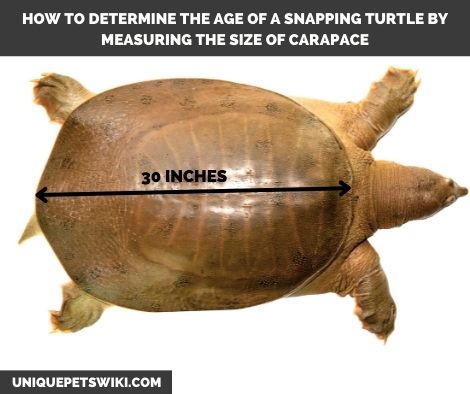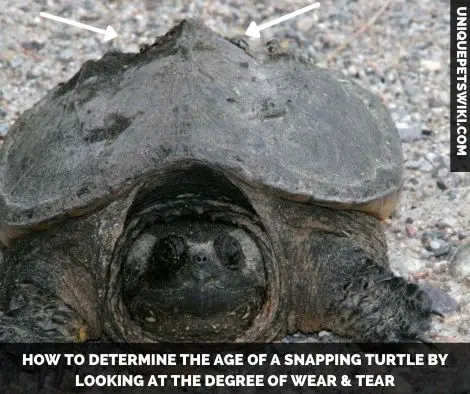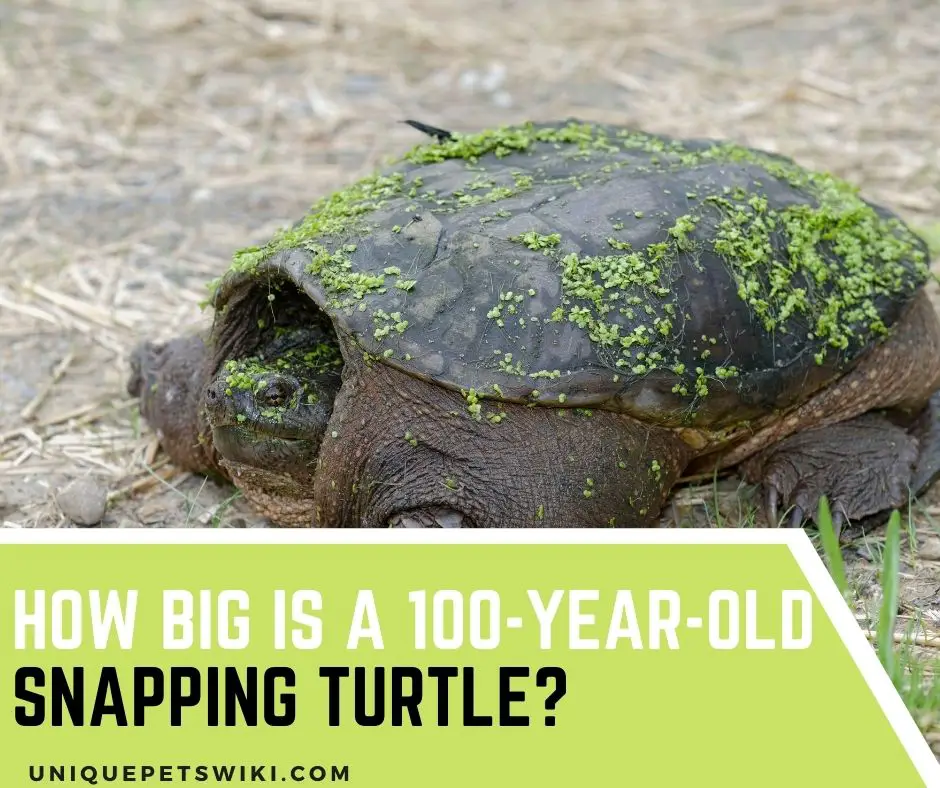An alligator snapping turtle owner, getting worried about the potential size of his animal when fully grown asked, “how big is a 100-year-old snapping turtle? Do they live that long in captivity?” My response: Not exactly! There are very little to no records about a captive or wild snapping turtle that lived for 100 years. The highest number of years a captive snapping turtle was known to live is 80 years, although they can surpass that and live for up to 100 years, it is very rare.
Both in the wild and in captivity, the chances of these animals living that long is dependent on their environment. In the wild, snapping turtles are predisposed to lots of danger as hatchlings and juveniles. However, once they could make it past that stage to adulthood, they can live longer.
On the contrary, captive snapping turtles that should be expected to live even longer since they are well taken care of rarely live up to 70 years and above. The reason for this is because several of these animals in captivity die because of poor husbandry and poor habitat setup. Thus, in the absence of predators, other factors such as the aforementioned shorten the lifespan of captive snappers.
In this article, we’ll look at the size of a 100-year-old snapping turtle and where such turtle was first recorded. Also in the article, we’ll discuss how to determine the age of a snapping turtle by measuring its carapace, counting the annuli on its scutes, and looking at the degree of wear and tear of the shell.
Keep reading!
Contents
The Lifespan Of The Snapping Turtle
Snapping turtles (both the common and alligator species) are the largest water turtles ever known. They have a long lifespan of 20 – 70 years with an average of 30 years.
Adult snapping turtles, unlike hatchlings, do not have as many predators in the wild. The hatchlings rarely make it to sexual maturity without being eaten by predators. But they can live for up to 30 years after escaping that phase.
Snapping turtles in captivity tend to live longer than they would in the wild because they don’t have any predators. Quality husbandry and a well-designed habitat are, of course, required for this to happen.
Even when there are no predators in captivity, poor husbandry and poor habitat setup are the leading causes of captive snappers’ reduced longevity. However, if your husbandry is perfect in combination with a suitable environment, your pet snappers can live for up to 50 years.
How Big Is A 100-Year-Old Snapping Turtle?

Photo credit: ERIC SUAREZ
Going by a rough estimate, a 100-year-old snapping turtle will weigh about 125 pounds. This estimation is informed by the findings from the research done by the Florida Fish and Wildlife Conservation Commission (FWC) in 2014.
In 2014, three alligator snapping turtles were found trapped in a hoop net in the New River, North of Gainesville by the FWC. Out of the three animals, one, which was a male weighed 100 pounds and was estimated to be 80 years old after several studies. While the other, a 46-pound female was estimated to be 40 years old.
Although this is not the standard weight for all snapping turtles of the same age, the findings give us an insight into how big a 100-year-old snapping turtle would be.
3 Basic Ways To Estimate The Age Of Snapping Turtles
It’s not always easy to figure out how old a turtle is, especially if you cannot tell when it was born. Regardless, there are several effective approaches that you can use in determining the age of a snapping turtle or any other turtle species for that matter.
However, keep in mind that these methods aren’t as accurate as knowing the exact date the turtle was born; they’ll only give you a rough estimate. You can use the following methods to figure out how old your snapping turtles are:
Measuring The Size Of Carapace

A wild snapping turtle’s age can also be determined by measuring the length of its carapace. We all know that plants and animals grow in size as they grow or age and that after a certain age (once full maturity is reached), the rate of growth slows until it eventually stops.
As a result, measuring the length of the carapace is a simple way to determine the age of your snapper.
When hatchling snapping turtles emerge from the eggshell, they are always around the size of a quarter. These hatchlings will grow to be so enormous with an average carapace length of 11 inches for females and 13.3 inches for males within a few years of reaching sexual maturity around the age of 10 – 19.
As precise as this method may appear, a snapping turtle’s growth rate can be altered and will vary greatly based on the availability of food, the turtle’s location, and other environmental factors.
Snapping turtles are thought to grow continuously throughout their lifetimes, but at a very sluggish rate as they get older.
Counting The Annuli Rings (Growth Rings)
Turtle and tortoise annuli rings are also known as growth rings because each ring on each scute of their carapace is thought to represent a calendar year.
The annuli ring on the carapace of snapping turtles tells more about times of food abundance and quick development rate than the calendar years they have lived, therefore this assumption isn’t totally correct.
Regardless, counting your turtle’s annuli rings might give you a rough approximation of the snapper’s age.

The Degree Of Wear And Tear Of The Snapping Turtle’s Shell
You can estimate how long a snapping turtle has lived by looking at the degree of wear and tear on its shell. However, for an unskilled enthusiast, this isn’t always as simple as it sounds, as you may still be unable to make an exact guess.
It is recommended that you take your turtle to a veterinarian that specializes in turtles at this point so that he may check the turtle’s shell and skin for signs of age. This is something that these kinds of veterinarians have been trained to do.

FAQs
Snapping Turtle Size
Snapping turtles aren’t the same in size across genders. Males are typically bigger and heavier than females of the same age. However, the differences in body size in snapping turtles are only visible when the animals have grown to full adults. While they’re still hatchlings and juveniles, they measure and weigh the same irrespective of their sex.
Hatchlings usually are between 1.5 – 2.5 inches long and weigh only a few ounces (about a quarter). Within 5 years, the males will attain sexual maturity and at this age will measure between 6 – 7 inches while the females get to sexual maturity later in years between 4 -7 years or even 12 years.
How Big Is A 1-Year-Old Snapping Turtle?
Going by the analysis above, a 1-year-old snapping turtle will measure between 3 – 4 Inches.
How Long Do Snapping Turtles Live?
Snapping turtles live an average of 30 years. With optimal care in captivity, they can live for up to 50 years or above.
How Can You Tell How Old A Snapping Turtle Is?
You can’t tell exactly how old a snapping turtle is except you know when the turtle was born. However, using several techniques, you can make an estimated guess of a snapping turtle’s age. These methods include:
* Measuring the carapace (shell) of the animal.
* Counting the growth rings also called annuli rings (this method to some extent isn’t completely reliable).
*Analyzing the turtle’s physical features to measure the degree of wear and tear of the shell and other body parts.
How Old Is A 100 Ib Snapping Turtle?
A 100 pound (Ib) snapping turtle is approximately 80 years old. This is according to the research done by the Florida Fish and Wildlife Conservation Commission (FWC) in 2014.
How Old Would A 65 pound Snapping Turtle Be?
A 65-pound snapping turtle will be about 54 – 60 years old.
Wrapping Up
The snapping turtles are a huge turtle species that grow to be between 8 and 14 inches (20 and 36 cm) long, with a record length of 19.3 inches (49 cm). Their average weights range from 10 to 35 pounds (4.5 to 16 kg), with a maximum weight of 75 pounds (34 kg).
These animals have a long lifespan of 30 years on average and will live longer than that if you provide an optimal environment for them.
While the males are typically larger and heavier than females, keep in mind that their size is also determined by their diet. That is the amount of food they eat. The more food they consume, the bigger and heavier they get.
